All About Pyramid Lake Fisheries Hatcheries
Each year, our hatchery system produces between 600,000 and 1,000,000 sub-catchable Lahontan Cutthroat trout for release into Pyramid Lake and the lower Truckee River. We have a complex of three different trout hatcheries and two hatcheries that provide Cui-ui plants for the lower Truckee River.
With federal grants from the Desert Terminal Lakes Program, during the last three years, Pyramid Lake Fisheries has been able to upgrade our trout hatcheries with new plumbing, water tanks, ultra-violet systems, and state-of-the-art filtration systems. We consider our hatchery facilities top-notch and ready to maintain quality fishing for years to come.
The latest research on the return of micro-tagged trout indicates that the best survival and return for our investment occurs with trout reared to 4 inches and released to the lake in October as soon as inshore waters cool enough for survival and before the abundant invertebrate population declines. At this stage, these young fish can switch from a hatchery diet to the more natural feed in the lake.
Hatcheries on the Hill
Hatcheries on the River
Hatchery on the Lake Shore
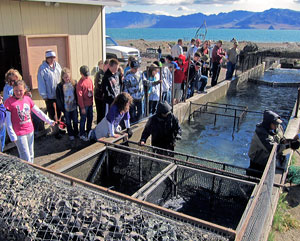
Students from Susanville watch personnel sort cut-throat trout at the head of the spawning channel.
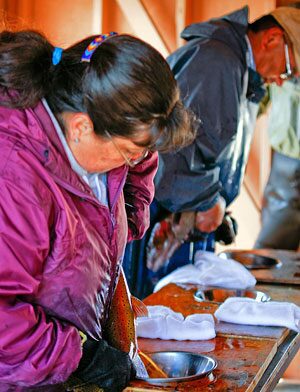
Denise Shaw and Norm Frazier are taking eggs for the 2011 spawn.
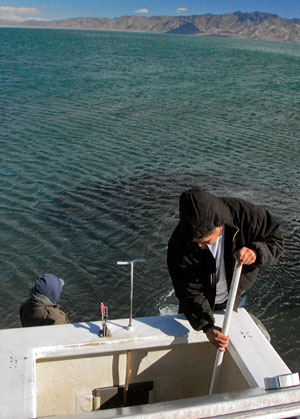
Stocking trout at Warrior Pt., is the last step in our hatchery process.
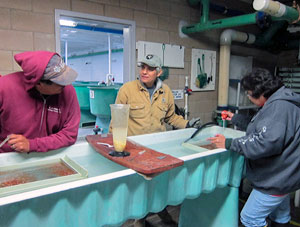
Desmond and Betsy picking eggs from the 2011 spawn at the Dunn Hatchery while Robert Eagle talks shop.
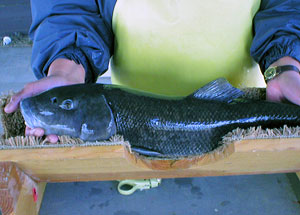
Cui-ui at Dunn Hatchery.
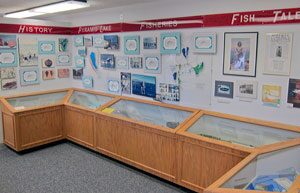
Visitors display at the Du
Hatcheries
Dunn Hatchery
Dunn Hatchery is located in Sutcliffe, on the west shore of Pyramid Lake. The facility was named after Peter Dunn, a tribal member who lost his life during the early phases of the program. Hatchery construction commenced in 1974, and fish production was initiated in 1975.
This hatchery is a 95% reuse facility, and production is limited to 2,500 pounds because of its small size. Up to 400,000 trout eggs are incubated here annually. The hatchery is also used as a training base for tribal members to gain experience and education in fish husbandry.
Early spring to late spring tours are often available here and at the Lake Operations facility, where thousands of fingerlings and stocking-size cut-throat trout can be observed outdoors in the rearing pools, raceways, and spawn channel. For hatchery tours, please call (775) 476-0500.
Koch Cui-ui Hatchery
The Koch Cui-ui Hatchery, located in Sutcliffe, Nevada, is dedicated to the memory of Dave Koch, who was the first to pioneer the culture of Cui-ui. The Cui-ui is a rare sucker-type fish that today is only found in Pyramid Lake, NV. This lake sucker, once found in both Winnemucca Lake and Pyramid Lake, was listed as an endangered species in 1967. Although the fish is long-lived ( up to 40 years), it had difficulty in ascending the Truckee River to spawn due to diverted flows and changing river access as lake elevations declined. The hatchery was constructed in 1974 to facilitate and supplement the recovery of this species in Pyramid Lake. The hatchery raises the endangered Cui-ui to supplement the population in the lake.
Hatcheries
Big Bend Hatchery
The Big Bend Hatchery is located in Wadsworth, NV, along the Truckee River. This facility was designed to raise Lahontan cut-throat trout (LCT) to the fingerling stage and then plant them into the river. The hope is that the LCT will imprint on the river water and return to this area to spawn. In recent years, the Big Bend Facility was converted for the incubation and release of Cui-ui to a wetland area along the Truckee River, which allows larval Cui-ui to enter the river and migrate naturally down to Pyramid Lake.
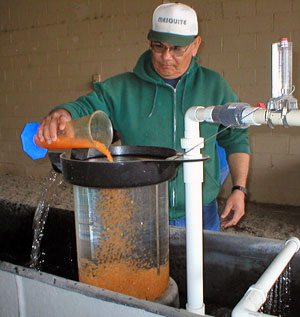
Norm Frazier adds cut-throat eggs to a hatching jar at the Big Bend Hatchery.
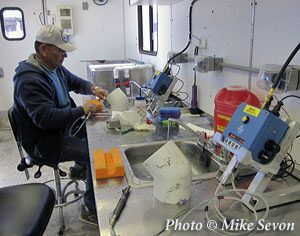
Norm Frazier is tagging in the new fish tagging trailer.
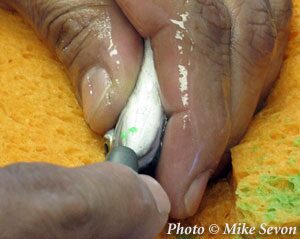
Close-up of injecting an elastomer marking in a 10-month-old cut-throat.
Hatcheries
Numana Hatchery
Numana Hatchery is located 8 miles north of Wadsworth, NV on Highway 447. This facility was dedicated to the people of Pyramid Lake and their efforts to restore the Hupa-Agai (cutthroat trout). The hatchery, completed in 1982, is named after Captain Dave Numana, a tribal leader, rancher and peacemaker. Numana Hatchery is the largest hatchery within the Pyramid Lake Fisheries with a total fish capacity of 20,000 pounds. Eggs taken at Lake Operations in the spring are transported here and raised from fry to fingerling size before being transported back to Sutcliffe for acclimation to the alkaline water of Pyramid Lake. Up to 800,000 eggs are incubated here annually.
At this hatchery, 10 to 15 % of all fish raised are tagged with either a coded-wire tag or an injection of a bright colored plastic elastomer. Pyramid Lake Fisheries has developed a portable fish tagging trailer that facilitates the tagging process. These tags allow fisheries personnel to look at the performance of certain year classes of fish and evaluate the success of different stocking strategies. Anglers also help in this effort and retrieve noses from tagged fish, providing them to biologist after a day of fishing at the lake.
Hatcheries
Lake Operations
Lake Ops also serves the important function of spawning Lahontan cut-throat trout (LCT) for each year’s production. The Lake Operations Facility (Lake Ops) is located in Sutcliffe, NV, on the western shore of Pyramid Lake. Lake operations, constructed in 1980, is primarily an acclimation facility. Pyramid Lake is the source of water for Lake Ops, with an intake pipeline that runs east into Pyramid Lake that takes cold water from a depth of 50 feet. The LCT is reared in freshwater in the hatcheries; they are then acclimated to the more saline and alkaline lake water before being released into Pyramid Lake. After being reared to a minimum size of 4 inches,cut-throat trout are transferred to Lake Ops for acclimation and stocking in the fall when water temperatures on the shore are cool enough for trout survival. Research shows fish stocked at this size can transfer from a diet of hatchery pellets to invertebrates at this stage for optimum survival.
In March, yearling cut-throat is placed into circular tanks. The outflow from these tanks is diverted down a spawning channel to the lake. Mature fish key on the scent of the juvenile, “attraction” fish and ascend the spawning channel where they can be sorted for spawning. This is the high point of the year and the main attraction for visitors. The fish entering the spawning channel are sorted by sex and maturity. Weekly spawns take place from early April through May until the annual production goal is met. On a normal year, Pyramid Lake Fisheries will take up to 1.5 million eggs and rear 800,000 to 1 million trout for release.
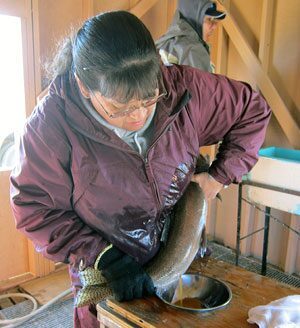
Denise Shaw takes eggs from a female cut-throat trout for distribution to the Numana Hatchery.
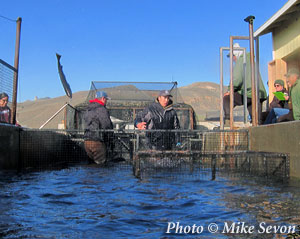
A fish-eye view of hatchery personnel selecting fish to spawn.
